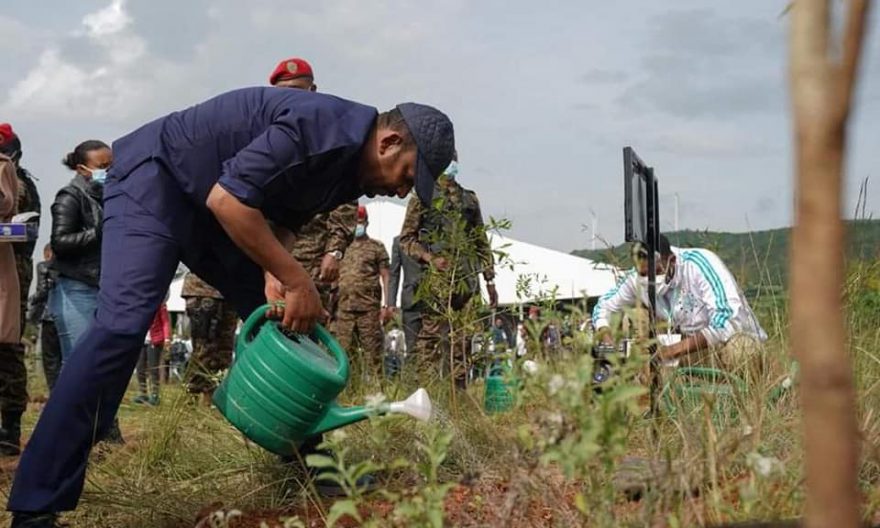
Ethiopia is gifted with a variable climate ranging from tropics to subtropics. Nonetheless, the rapidly increasing populations, depletion of soil fertility, landlessness, climate change, deforestation, political turmoil, and degradation of natural resources are among the current problems facing the country.
Ethiopia is the second-most populous country in Africa and its economy is greatly dependent on agriculture with rain-fed, smallholder farming representing more than 90 percent of national agricultural outputs. Hence, this sector is a major driver of forest and land degradation. If somebody combines rapid population growth and associated problems such as fuelwood needs, recurrent droughts, and entrenched poverty, the pressure on Ethiopia’s natural resources is immense.
Taking these facts into accounts, efforts have been made by the successive governments of Ethiopia to avert land and forest degradation that pose a critical threat to land and livelihoods. Besides, the country designed policies and approaches to bring economic growth by protecting the existing forests and restoring degraded areas. Accordingly, there is no doubt that there has been a major effort on the part of the Ethiopian government to tackle environmental challenges, especially, very serious deforestation problems.
Ethiopia half a century ago, had around 40 percent of forest cover. Today this figure reaches around 17 percent. Cognizant of that, on May 18, Prime Minister Abiy launched the 2021 edition of the third Green Legacy Initiative, a tree-planting campaign aimed at curbing the effects of climate change and deforestation.
This planting tree seedling program is expected to tackle environmental problems. Furthermore, Ethiopia had planned to plant 6 billion tree seedlings under the theme, “Let’s Adorn Ethiopia”. Despite the coincidence with the sixth National General Elections and the challenges of COVID-19, among others, the nation is determined to continue with the Green Legacy Initiative by planting 6 billion seedlings this year.
The initiative of planting tree seedlings has been designed to preventing flooding, food insecurity, environment-related conflicts, and other adverse effects. Furthermore, it focused on restoring the country’s green cover, eliminating erosion and pollution, reducing conflicts arising due to environmental degradation and reduction of natural resources, and measures to support Ethiopia’s agricultural sector and economy, the Prime Minister said.
Apart from the green legacy initiatives, the commitment of Ethiopia was taken as an exemplary leadership in climate action. Ethiopia’s firm commitment to the green legacy program has obtained acknowledgment from others including neighboring countries, diplomats, ambassadors, and so on to participates in planting tree seedlings activities. Besides, Ethiopians regardless of age, sex, political differences, position and opinion, educational background, and the like have taken part in putting their green legacy in this year.
The closing ceremony of the 3rd round of the green fingerprint program held in Lume Woreda of East Shoa Zone of Oromia State was held yesterday. During the occasion, Prime Minister Dr. Abiy Ahmed said, “in 2019, Ethiopia has planned to plant 20 billion seedlings in four years’ period, and has planted 18 billion seedlings in the last three years. This is a great success,” he said.
“This shows that the plan of “green legacy” is not an idea, rather it is just a tangible, attainable, and applicable plan which can make a difference,” he said. He further noted that “the green legacy achievement is one indication that all the work that we have started will be completed in accordance with the plan and ensure Ethiopia’s prosperity.”
“If 7 billion tree seedlings are planted next year, it will be 25 billion which is more than the plan of the country. If we can replicate and achieve this success through our agriculture, export, basic services, and other plans, Ethiopia’s prosperity will be realized in a short period of time,” he said.
In fact, Ethiopia’s green legacy work has been in line with the United Nations Green Legacy Initiative. And it gets acknowledgments from the UN and other stakeholders. According to the UN Resident and Humanitarian Coordinator for Ethiopia, Dr. Catherine Sozi, Ethiopia has underscored the importance of trees and forests in mitigating the impact of climate change. Because the Green Legacy Initiative has hugely contributed to environmental restoration and conservation efforts.
Furthermore, Ethiopia’s Green Legacy is also in line with the following global initiatives (i) the UN Decade on Ecosystem Restoration for which many UN agencies are engaged; (ii) UNEP vision for 2020 as Super Year for nature; (iii) the Nature-based Solutions and building back better after COVID-19; (iv) global environmental agendas including Paris Agreement on climate change, the Targets on Land restoration, the post-2020 biodiversity framework, planet pillar of UN Sustainable Development Cooperation Framework (UNSDCF), among others.
The acceptance and the participation of the people play a key role in the success and achievement of this year’s green legacy initiative.
Instead of frightening, Ethiopian winter is becoming more and more longing. Apart from routine works, it gives the opportunity to do various morally acceptable activities namely houses for the weak are being built, trees are being planted, urban areas are being cleaned, farming is being done extensively, and so on. More importantly, the people are getting a lot of opportunities to change the country,” Prime Minister said. He, therefore, called on Ethiopians to repeat their unity and obedience in all fields.
Deputy Prime Minister and Minister of Foreign Affairs, Demeke Mekonnen, on his part said, in the last three years, Ethiopia is putting a monument via green legacy initiative. The initiative has significantly contributed to adorning Ethiopia. So, “We need to expand this partnership and repeat success in all fields,” he said.
Ethiopian Minister of Agriculture, Omar Hussein, on his part, said that Although Ethiopia has planned to plant 6 billion tree seedlings this year, 6.8 billion tree seedlings have been planted. This indicates the commitment and the devotion of the people.
“The fact that the country is still in crisis and the terrorist TPLF group poses a threat for the territorial integrity of the nation however the achievement of planting tree seedlings is a testament to the success of Ethiopia,” he said.
In fact, in this year, Ethiopia has passed through several ups and down situations such as the law enforcement operation in the Tigray region, the ongoing killings, displacement, and human rights abuses by the terrorist group TPLF in the Amhara and Afar regions, and foreign pressure and influences. Along with all problems, Ethiopia has succeeded in the plan of planting tree seedlings. The collaborative efforts of nations have significantly contributed to this success. This is an indication of keeping the promise while reaping the result of plant tree seedlings.
BY EPHREM ANDARGACHEW
THE ETHIOPIAN HERALD SEPTEMBER 7/ 2021




